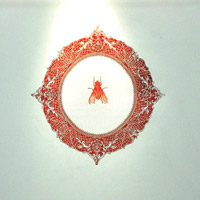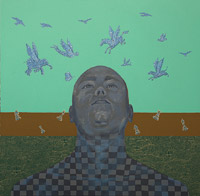The World Bank has been organizing art exhibitions globally since 2007. An open call invites artists from the selected regions to participate and send in their entries. The artwork is chosen on the basis of creativity and the artist’s ability to best translate the given topic. The selected works are owned by the World Bank art collection.
 Cooperation and interaction between countries is a step towards global growth and development and what better way to do this than by using art as the medium to kickstart these changes. Art is a medium to communicate thoughts, experiences and break barriers for a mutual cause. The objective of these series is to engage young minds and allow them to express themselves through the various themes. This year’s theme - Imagining our future together was on display in Bangladesh and New Delhi in the presence of the winning artists and finally displayed at the World Bank headquarters in Washington DC, USA. The exhibition in Bangladesh (8-13 November) was held at the National Art Gallery, Bangladesh Shilpakala Academy.
Cooperation and interaction between countries is a step towards global growth and development and what better way to do this than by using art as the medium to kickstart these changes. Art is a medium to communicate thoughts, experiences and break barriers for a mutual cause. The objective of these series is to engage young minds and allow them to express themselves through the various themes. This year’s theme - Imagining our future together was on display in Bangladesh and New Delhi in the presence of the winning artists and finally displayed at the World Bank headquarters in Washington DC, USA. The exhibition in Bangladesh (8-13 November) was held at the National Art Gallery, Bangladesh Shilpakala Academy.
The theme for 2011-2012, “Imagining Our Future Together” is the third in a series of the World Bank’s regionally- focused exhibitions; this year the exhibition focused on South Asia. The first series, ‘Africa Now! Emerging Talents from the Continent on the Move’ took place in 2007- 2009. The second series, ‘About Change in Latin America and the Caribbean’ took place in 2010- 2012. The participating countries from South Asia for this series are Afghanistan, Bangladesh, Bhutan, India, Maldives, Nepal, Pakistan and Sri Lanka. The results are out and amongst 25 winning artist, three are Nepali - Hit Man Gurung, Koshal Hamal and Prithivi Shrestha.
 Koshal Hamal, who is currently doing his MFA at Beconhouse University in Pakistan claims that he is “completely married to art”, and is totally overwhelmed by his work being selected. Feeling confident from this achievement, he hopes to be stronger and more dynamic in his further works. “This is not a housefly” – an acrylic on canvas work is one of his selected works. Inspired by the paintings of the Rana period when everything was exaggerated and glamorised and even the ordinary looked extraordinary, he paints an ordinary housefly, set in a very stylized frame borrowed from the dollar note, to emphasize its value. A play with the blank space of the canvas further emphasises the subject. He believes in following rules and so frames most of his subjects in his paintings after vast research, confining them with some sort of a regulation. He portrays this as a visual metaphor in context to contemporary socio-cultural values, the state of being “outstanding” the importance of power and beauty. He does not believe in filling the whole canvas with a painting but playing with the negative space, painting his subject with a 000 brush.
Koshal Hamal, who is currently doing his MFA at Beconhouse University in Pakistan claims that he is “completely married to art”, and is totally overwhelmed by his work being selected. Feeling confident from this achievement, he hopes to be stronger and more dynamic in his further works. “This is not a housefly” – an acrylic on canvas work is one of his selected works. Inspired by the paintings of the Rana period when everything was exaggerated and glamorised and even the ordinary looked extraordinary, he paints an ordinary housefly, set in a very stylized frame borrowed from the dollar note, to emphasize its value. A play with the blank space of the canvas further emphasises the subject. He believes in following rules and so frames most of his subjects in his paintings after vast research, confining them with some sort of a regulation. He portrays this as a visual metaphor in context to contemporary socio-cultural values, the state of being “outstanding” the importance of power and beauty. He does not believe in filling the whole canvas with a painting but playing with the negative space, painting his subject with a 000 brush.
 Prithivi Shrestha, works as a part-time illustrator and runs ‘Bindu’ a space for artists, which hosts various art events. His present work focuses on the mechanical lives we live and on the cycles of life and an end that everybody has to go through. His recent shift to conceptual paintings from painting social issues and daily life supports the given theme. His selected paintings, “Sky Land and Water” and “I want to fly” both reflect his fantasies. Our relation to the energy of the skies, land and water has been depicted to the mechanical moves of the chess board as a satire to all humans as mere players in a large game with a definite end.
Prithivi Shrestha, works as a part-time illustrator and runs ‘Bindu’ a space for artists, which hosts various art events. His present work focuses on the mechanical lives we live and on the cycles of life and an end that everybody has to go through. His recent shift to conceptual paintings from painting social issues and daily life supports the given theme. His selected paintings, “Sky Land and Water” and “I want to fly” both reflect his fantasies. Our relation to the energy of the skies, land and water has been depicted to the mechanical moves of the chess board as a satire to all humans as mere players in a large game with a definite end.
‘I want to fly’ is a visualisation of his dreams where he once again has superimposed the checked pattern of the chess board on his body with humans and animals flying above, a common desire for most people. Shrestha feels that the selection of Nepali artists on this platform is a definite message that will help establish us as equals in the international art scene. It should also prove to those who still believe contemporary Nepali art still lacks a global essence.
Hit man Gurung hails from Lamjung and is amongst the first batch of MFA graduates in Nepal. Having a keen interest in art since his childhood led him to pursue it as a career. Gurung often paints narratives of political and social issues and loves to paint the contrast between the ideal and the real. His selected paintings, “Save yourself first” and “Save the life together” are a series of two paintings of acrylic on canvas that represent the contrast in these titles. The ideology of saving the environment is well demarcated in his paintings where you are asked to choose your personal house or a tree in the process to save the environment. Gurung is keen to take part in the exhibitions to be held in Dhaka and New Delhi, and to meet and interact with all the winning artists. He feels that the contemporary autistics are faced with a challenge to justify the vast legacy left behind by past artists besides the opportunity of learning from them. Contemporary artists believe in questioning, analysing and reinterpreting situations which itself is a challenge on its own, he comments.
Talking to these three artists and looking at their works makes one realize that Nepal is not far behind in the international arena of art. The varying styles, themes and ways of expressing perspectives that are understood globally show a diversity and maturity in thoughts and ideas. Prominently known for its traditional art and practises, Nepal has many foreigners from far and near coming to learn the art and its practice. The selection of these Nepali artists in the World Bank exhibition has however positioned Nepal in the international level in the contemporary art scene too.










